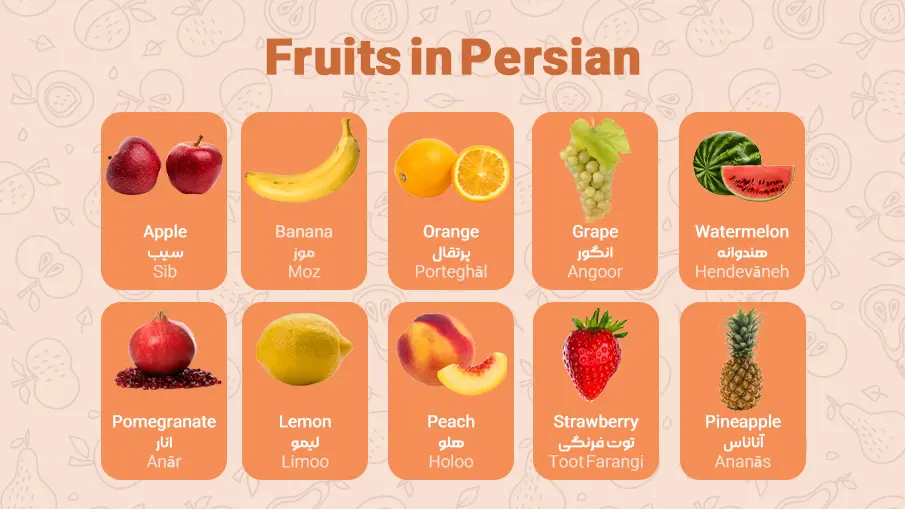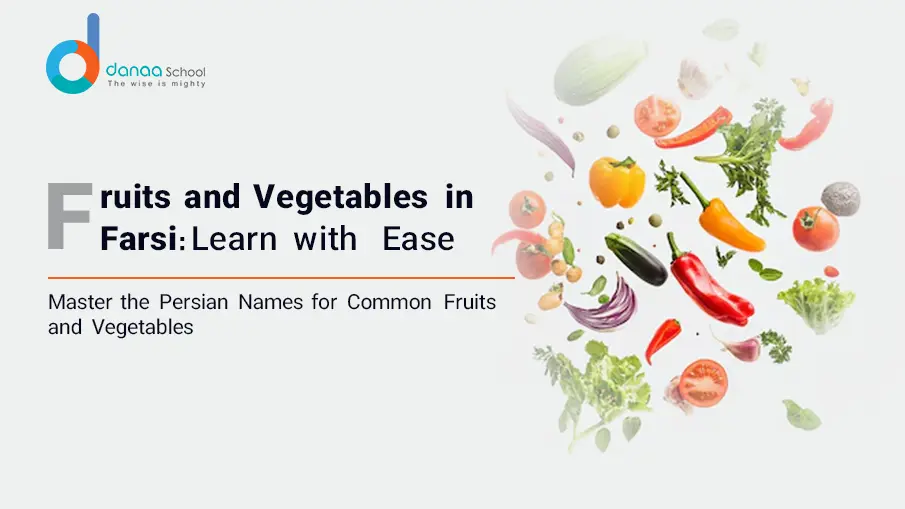Learning the names of fruits and vegetables in Farsi (Persian) is a great way to start your journey into the language. Whether you are a beginner or just looking to expand your vocabulary, understanding everyday items like fruits (میوهها) and vegetables (سبزیجات) will help you in day-to-day conversations.
In this guide, we will explore the names of common fruits and vegetables in Persian and their pronunciations, along with some useful tips on how to enhance your Farsi learning experience with platforms like Danaa School.
Fruits and Vegetables in Persian
One of the best ways to start learning any language is by mastering basic, everyday vocabulary. In Persian, fruits are called “میوهها” (Miveh-hā), and vegetables are known as “سبزیجات” (Sabzijāt). Understanding these names can be beneficial whether you’re visiting a Persian-speaking country, shopping at a market, or just interested in the culture.
Let’s explore some commonly known fruits and vegetables, with their Persian names and phonetic pronunciations.
Fruits in Persian (میوهها)
 Here is a list of some popular fruits in Persian:
Here is a list of some popular fruits in Persian:
-
Apple: سیب (Sib)
Apples are widely consumed in Iran and have deep cultural significance. The word “Sib” is simple and easy to remember.
-
Banana: موز (Moz)
Bananas are one of the easiest fruits to spot, and their Persian name is equally easy to recall.
-
Orange: پرتقال (Porteghāl)
Oranges are abundant in Persian cuisine and are often used to make juice. The word “Porteghāl” is derived from “Portugal,” as the fruit was introduced to Iran from there.
-
Grape: انگور (Angoor)
Grapes are a staple in Persian dishes, and the word “Angoor” is quite similar to its English counterpart.
-
Watermelon: هندوانه (Hendevāneh)
A summer favorite, watermelon is known for its sweet, refreshing taste in Iran.
-
Pomegranate: انار (Anār)
A national symbol of Iran, pomegranates play a central role in Persian culture and cuisine. The word “Anār” is a must-know for anyone interested in Persian fruits.
-
Lemon: لیمو (Limoo)
Lemons are extensively used in Persian dishes, especially in salads and soups.
-
Peach: هلو (Holoo)
Peaches, called “Holoo” in Persian, are widely available in Iran and often used in desserts.
-
Strawberry: توت فرنگی (Toot Farangi)
Interestingly, “Toot Farangi” literally means “foreign mulberry,” as strawberries were introduced to Iran much later.
-
Pineapple: آناناس (Ananās)
Pineapple retains a similar name in Persian, making it easy to remember.
Vegetables in Persian (سبزیجات)

Vegetables are just as important in Persian cuisine as fruits. Here’s a list of commonly used vegetables:
-
Potato: سیب زمینی (Sib Zamini)
Literally translated as “earth apple,” potatoes are essential in many Persian dishes.
-
Tomato: گوجه فرنگی (Goj-e Farangi)
Tomatoes are referred to as “foreign berries,” highlighting their introduction from other parts of the world.
-
Carrot: هویج (Havij)
Carrots, or “Havij,” are widely used in Persian salads and stews.
-
Cucumber: خیار (Khiār)
A refreshing addition to many Persian dishes, cucumbers are known as “Khiār.”
-
Onion: پیاز (Piyāz)
A fundamental ingredient in Persian cooking, “Piyāz” is a must-learn word.
-
Lettuce: کاهو (Kāhoo)
Lettuce, or “Kāhoo,” is a key part of salads served with most Persian meals.
-
Spinach: اسفناج (Esfanāj)
Spinach, known as “Esfanāj,” is used in various Persian soups and stews.
-
Garlic: سیر (Sir)
Garlic, or “Sir,” is a staple flavoring in Persian dishes, giving meals their aromatic kick.
-
Eggplant: بادمجان (Bādemjān)
Eggplant is a prominent vegetable in Persian cuisine, featured in dishes like “Kashk-e Bādemjān.”
-
Cabbage: کلم (Kalam)
Cabbage, known as “Kalam,” is often used in stews and pickles.
Why Learning Food Vocabulary Is Important in Farsi
Food plays a significant role in Persian culture, and knowing the names of fruits and vegetables can enhance your connection with the language and its people. When you visit a Persian-speaking region, knowing basic words like “Sib” for apple or “Kāhoo” for lettuce will help you navigate markets, restaurants, and even social gatherings with ease.
Furthermore, food vocabulary is often one of the first things learners tackle because it’s so practical. It allows you to engage in simple conversations and understand a big part of Persian life — the food culture.
Practical Tips for Memorizing Persian Fruits and Vegetables
-
- Use Flashcards: Create flashcards with the name of the fruit or vegetable on one side and the Persian word on the other. This will help reinforce memory through repetition.
-
- Watch Persian Cooking Shows: By watching Persian cooking shows, you’ll frequently hear the names of ingredients being used, giving you both auditory and visual reinforcement.
-
- Practice at the Market: If you live in an area with Persian markets, take the opportunity to practice your vocabulary. Try labeling fruits and vegetables in your home with their Persian names for constant exposure.
-
- Enroll in Online Classes: Platforms like Danaa School provide a structured approach to learning. With dedicated lessons on food vocabulary, you’ll quickly become familiar with essential terms.
Discover How to Learn Farsi Vocabulary Effectively.
Learning Fruits and Vegetables in Farsi with Danaa School
If you are looking for structured ways to learn Farsi, platforms like Danaa School offer specialized lessons that can boost your vocabulary and pronunciation skills. With interactive lessons, real-life conversation practice, and focused vocabulary lists, you can deepen your understanding of the Persian language.
Danaa School focuses on an immersive learning experience, which is critical when trying to learn complex words like those for fruits and vegetables in Persian. They often use cultural references and practical situations, like going to a Persian market, to help students learn faster and retain knowledge longer.
Find Your Ideal Teacher
At Danaa School, you can choose your Farsi tutor from a selection of qualified and experienced teachers. Begin an exceptional journey into the world of Persian language!
Book Your Trial Lesson
FAQs
What is the Persian word for apple?
In Persian, apple is called “سیب” (Sib).
How do you say banana in Farsi?
Banana is known as “موز” (Moz) in Farsi.
What is watermelon called in Persian?
Watermelon is referred to as “هندوانه” (Hendevāneh) in Persian.
How do you say garlic in Persian?
Garlic is called “سیر” (Sir) in Persian.
What is the word for tomato in Farsi?
Tomato is “گوجه فرنگی” (Goj-e Farangi) in Farsi.
How do you say cucumber in Persian?
Cucumber is “خیار” (Khiār) in Persian.
Conclusion
Learning the names of fruits and vegetables in Persian is a practical and enjoyable way to expand your Farsi vocabulary. With consistent practice, using tools like flashcards, cooking shows, and structured lessons from platforms like Danaa School, you’ll master these essential words in no time.
From the humble apple, “Sib,” to the flavorful garlic, “Sir,” these words will serve as your foundation for more advanced conversations in Persian. Whether you’re a beginner or looking to enhance your skills, the journey of learning Farsi starts with understanding everyday vocabulary. Enroll now.
Want to Learn Farsi at Danaa School?
Here are the best resources for you!









